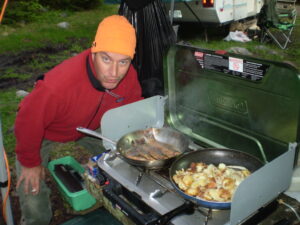Catch and Release or Kill

By Josh Reynolds
For the modern fly-fishing angler, there is controversy afoot. It seems that the social and political polarization of the past few years has threatened to pollute a sport that I love. In the angst-ridden world of social media, throughout the internet of fishing blogs, in the pages of traditional fishing magazines and probably in the cigar and scotch- soaked confines of exclusive fly-fishing ranches and sporting camps there is a debate raging on killing vs. catch and release.
Honestly, it’s not much of a debate. What I see and read is a lot of one-sided “kill shaming”. It goes further than that. How about “photo shaming”. That’s when sanctimonious trolls have taken Umbridge with a person who pulls a fish out of the net to take a picture – only to be released moments later. “It stresses the fish”. “You are holding it wrong”. “It’s choking. These are fellow fisherman doing this mind you, not PETA zealots.
Question
Let’s pose a reasonable question that only has one true answer. Have you ever killed a fish? If you fish on a regular basis, even if you have released every fish you’ve ever caught, you’ve killed a fish. Some kills are obvious. Blood coming from the gills is certain death. That swallowed fly that you fight to retrieve instead of just cutting the line, that’ll do it. You play that feisty West Branch Salmon too long – they’ve only got so much fight – just like us. If you aren’t willing to kill a fish or can’t acknowledge that in the act of catch and release, you will likely kill fish, may I suggest you find another, less lethal hobby.
Now that I’ve taken the sanctimonious, catch and release trolls to task, here’s some balance. We as fisherman should know the waters we fish – not all are created equally, nor are the fish within those waters. If you want to eat fish, fish the waters that are loaded with little fish, killing a few can be good for a fishery. There are native, wild brook trout ponds in Maine that are loaded with little trout – too many to grow big fish. If it’s legal according to the law book, chances are keeping a couple to eat will have no negative impact on the population. In fact, there is a good argument to be made that you should put back the small ones AND the big ones, both are important, keep the ones in the middle.
If you are fishing a true trophy water, FFO, catch and release only, barbless hooks – know how to make a clean release, keep the fish in water, don’t play them too long. If you can’t easily retrieve the fly, snap it off and let ‘em go. Finally, if your fishing for Trout and the water has warmed up above 70F, it’s time to fish for something else. The fish are already stressed.
Place for Both
The point that I’m trying to make is this. There is a time and a place, and should be a space for both catch and release and for killing. It’s not an either-or scenario, it’s a both and scenario. All of us who love to fish should be able to make accommodations for differing points of view – even if we disagree with it. Keep your shaming, sanctimony to yourself.
We have to eat. For some of us, eating what we have killed – fresh, wild, natural fish that we have taken from the land is not only food for our bodies, but food for our soul. This connects us to who we are as humans in the most basic and important sense. Killing to just kill is barbaric and cruel. Killing to sustain your life creates an intimate bond with nature that too few experience today in my view. I will continue to kill and eat fish when the time is right. I won’t judge those who think me a heathen, but if public shaming is your game, prepare to be called out.
Josh Reynolds is the Assistant Editor of The Journal. He can be reached at [email protected]
For more articles about hunting, fishing and the great outdoors, be sure to subscribe to the Northwoods Sporting Journal.
For free access to past digital issues of the Northwoods Sporting Journal, click here.
